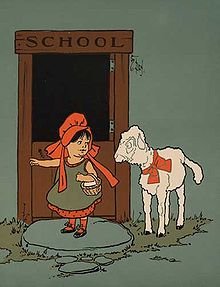The True Story Behind ‘Mary Had a Little Lamb’
The origins of the beloved nursery rhyme “Mary Had a Little Lamb” can be traced back to a real-life event involving a young girl named Mary Sawyer and her pet lamb in the early 19th century. On the 24th of May, 1830, the charming story that inspired this iconic rhyme was published, capturing the public’s imagination with its simplicity and warmth. Mary Sawyer, who lived on a farm in Sterling, Massachusetts, cherished her lamb, which had a significant role in her everyday rural life, emblematic of the era’s close-knit relationship between humans and their animals.
As the story goes, Mary’s pet lamb followed her to school one day, much to the amusement and astonishment of her classmates and teacher. This delightful incident was later immortalized in the poem by Sarah Josepha Hale. Historical records and anecdotes corroborate the story, highlighting the authenticity of this endearing tale. In her later years, Mary Sawyer herself recounted this event, noting the lamb’s attachment to her and its subsequent journey to the classroom.
In a time when rural settings were dominant, and animals played a crucial role in daily life, the story of Mary and her lamb resonated deeply with the public. The early 19th century’s cultural and educational environment was one where simple, relatable stories could captivate the collective imagination. Farm animals were not merely livestock but integral to the family’s livelihood and education, often forming emotional bonds with their young caretakers.
Historical societies and archives, such as the Sterling Historical Society, provide additional details and verification of this story. They house documents and artifacts that shed light on the real Mary Sawyer and her famous lamb, further cementing the narrative’s place in American folklore. The publication of “Mary Had a Little Lamb” on the 24th of May, 1830, marked a significant moment in literary history, blending fact with poetic charm to create an enduring legacy.
Sarah Josepha Hale and the Publication of the Nursery Rhyme
Sarah Josepha Hale, born in 1788, was a prominent American writer and editor whose contributions to literature and culture have left an indelible mark. She is best known for authoring the beloved nursery rhyme, “Mary Had a Little Lamb.” Hale’s career was distinguished by her role as the editor of Godey’s Lady’s Book, one of the most influential women’s magazines of the 19th century. Her stewardship of the magazine not only provided a platform for women’s voices but also helped shape American literary tastes and cultural norms.
The publication of “Mary Had a Little Lamb” on May 24th, 1830, marked a significant milestone in Hale’s career. The poem was first published in a magazine and was met with immediate enthusiasm from readers. Its simple yet captivating narrative, combined with its rhythmic structure, made it an instant favorite among both children and adults. The poem’s story of a little girl’s affection for her lamb, which follows her to school, resonated with readers due to its universal themes of innocence and companionship.
Hale’s literary style in “Mary Had a Little Lamb” is characterized by its straightforward language and repetitive structure, which not only made it easy for children to memorize but also lent it a musical quality that has contributed to its lasting popularity. Literary critiques from the time of its publication often praised the poem for its charm and simplicity. Modern interpretations continue to highlight its impact as a foundational piece of children’s literature, noting how it has inspired numerous adaptations and renditions over the years.
The enduring legacy of “Mary Had a Little Lamb” can be seen in its continued presence in educational settings and its influence on children’s literature. For further reading on Sarah Josepha Hale’s contributions and the lasting impact of her work, readers may refer to external literary journals and publications such as The Poetry Foundation and JSTOR, which offer in-depth analyses and discussions on her legacy.

